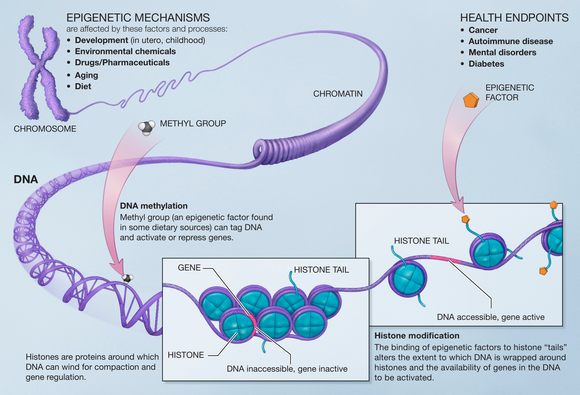
Biomarkers of aging are biomarkers that could predict functional capacity at some later age better than chronological age.[1] Stated another way, biomarkers of aging would give the true "biological age", which may be different from the chronological age.
Validated biomarkers of aging would allow for testing interventions to extend lifespan, because changes in the biomarkers would be observable throughout the lifespan of the organism.[1] Although maximum lifespan would be a means of validating biomarkers of aging, it would not be a practical means for long-lived species such as humans because longitudinal studies would take far too much time.[2] Ideally, biomarkers of aging should assay the biological process of aging and not a predisposition to disease, should cause a minimal amount of trauma to assay in the organism, and should be reproducibly measurable during a short interval compared to the lifespan of the organism.[1] An assemblage of biomarker data for an organism could be termed its "ageotype".[3]
Although graying of hair increases with age,[4] hair graying cannot be called a biomarker of ageing. Similarly, skin wrinkles and other common changes seen with aging are not better indicators of future functionality than chronological age. Biogerontologists have continued efforts to find and validate biomarkers of aging, but success thus far has been limited. Levels of CD4 and CD8 memory T cells and naive T cells have been used to give good predictions of the expected lifespan of middle-aged mice.[5]
Advances in big data analysis allowed for the new types of "aging clocks" to be developed. The epigenetic clock is a promising biomarker of aging and can accurately predict human chronological age.[6] Basic blood biochemistry and cell counts can also be used to accurately predict the chronological age.[7] Further studies of the hematological clock on the large datasets from South Korean, Canadian, and Eastern European populations demonstrated that biomarkers of aging may be population-specific and predictive of mortality.[8] It is also possible to predict the human chronological age using the transcriptomic clock.[9]
- ^ a b c Baker GT, Sprott RL (1988). "Biomarkers of aging". Experimental Gerontology. 23 (4–5): 223–39. doi:10.1016/0531-5565(88)90025-3. PMID 3058488. S2CID 31039588.
- ^ Harrison, Ph.D., David E. (November 11, 2011). "V. Life span as a biomarker". Jackson Laboratory. Archived from the original on April 26, 2012. Retrieved 2011-12-03.
- ^ Ahadi, Sara; Zhou, Wenyu; Schüssler-Fiorenza Rose, Sophia Miryam; Sailani, M. Reza; Contrepois, Kévin; Avina, Monika; Ashland, Melanie; Brunet, Anne; Snyder, Michael (2020). "Personal aging markers and ageotypes revealed by deep longitudinal profiling". Nature Medicine. 26 (1): 83–90. doi:10.1038/s41591-019-0719-5. PMC 7301912. PMID 31932806.
- ^ Van Neste D, Tobin DJ (2004). "Hair cycle and hair pigmentation: dynamic interactions and changes associated with aging". Micron. 35 (3): 193–200. doi:10.1016/j.micron.2003.11.006. PMID 15036274.
- ^ Miller RA (April 2001). "Biomarkers of aging: prediction of longevity by using age-sensitive T-cell subset determinations in a middle-aged, genetically heterogeneous mouse population". The Journals of Gerontology. Series A, Biological Sciences and Medical Sciences. 56 (4): B180-6. doi:10.1093/gerona/56.4.b180. PMC 7537444. PMID 11283189.
- ^ Horvath S (2013). "DNA methylation age of human tissues and cell types". Genome Biology. 14 (10): R115. doi:10.1186/gb-2013-14-10-r115. PMC 4015143. PMID 24138928. (Erratum: doi:10.1186/s13059-015-0649-6, PMID 25968125, Retraction Watch)
- ^ Putin E, Mamoshina P, Aliper A, Korzinkin M, Moskalev A, Kolosov A, Ostrovskiy A, Cantor C, Vijg J, Zhavoronkov A (May 2016). "Deep biomarkers of human aging: Application of deep neural networks to biomarker development". Aging. 8 (5): 1021–33. doi:10.18632/aging.100968. PMC 4931851. PMID 27191382.
- ^ Mamoshina P, Kochetov K, Putin E, Cortese F, Aliper A, Lee WS, Ahn SM, Uhn L, Skjodt N, Kovalchuk O, Scheibye-Knudsen M, Zhavoronkov A (October 2018). "Population Specific Biomarkers of Human Aging: A Big Data Study Using South Korean, Canadian, and Eastern European Patient Populations". The Journals of Gerontology. Series A, Biological Sciences and Medical Sciences. 73 (11): 1482–1490. doi:10.1093/gerona/gly005. PMC 6175034. PMID 29340580.
- ^ Peters MJ, Joehanes R, Pilling LC, Schurmann C, Conneely KN, Powell J, et al. (October 2015). "The transcriptional landscape of age in human peripheral blood". Nature Communications. 6: 8570. Bibcode:2015NatCo...6.8570.. doi:10.1038/ncomms9570. PMC 4639797. PMID 26490707.